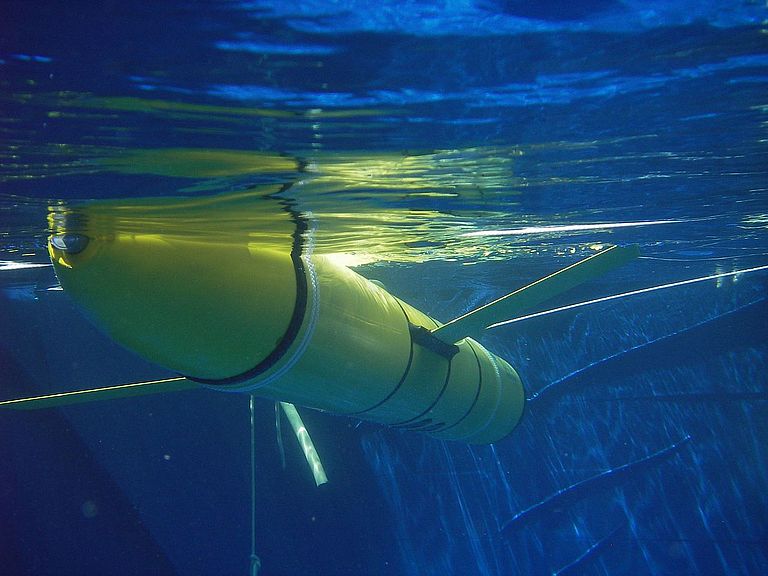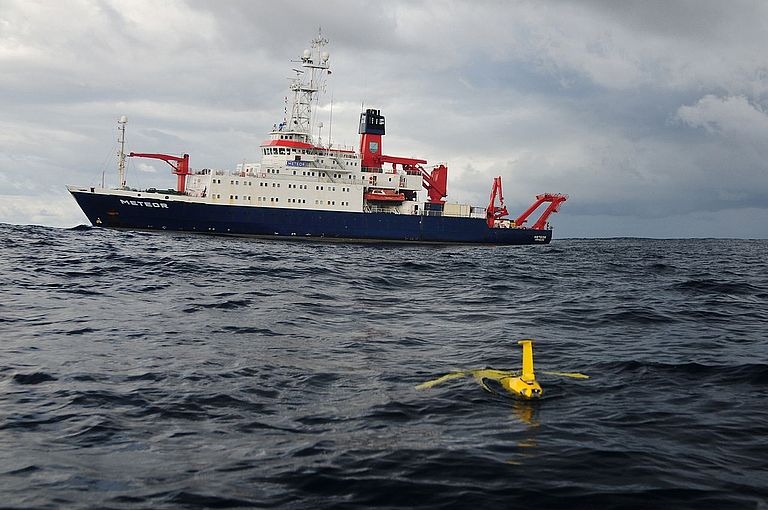A swarm for research
January 14, 2010/Kiel. The Leibniz Institute of Marine Sciences (IFM-GEOMAR) in Kiel, Germany, recently obtained the biggest fleet of so-called gliders in Europe. These instruments can explore the oceans like sailplanes up to a depth of 1000 metres. In doing so they only consume as much energy as a bike-light. In the next years up to ten of these high-tech instruments will take measurements to better understand many processes in the oceans. Currently scientists and technicians prepare the devices for their first mission as a „swarm“ in the tropical Atlantic.
They may look like mini-torpedoes, yet exclusively serve peaceful purposes. The payload of the two-metres-long yellow diving robots of the Leibniz Institute of Marine Sciences (IFM-GEOMAR) in Kiel, Germany, consists of modern electronics, sensors and high-performance batteries. With these devices the marine scientists can collect selective measurements from the ocean interior while staying ashore themselves. Moreover, the gliders not only transmit the data in real time, but they can be reached by the scientists via satellite telephone and programmed with new mission parameters.
As such the new robots represent an important supplement to previous marine sensor platforms. „Ten year ago we started to explore the ocean systematically with profiling drifters. Today more than 3000 of these devices constantly provide data from the ocean interior“, explains Professor Torsten Kanzow, oceanographer at IFM-GEOMAR. This highly successful programme has one major disadvantage: the pathways of the drifters cannot be controlled. „The new gliders have no direct motor, either. But with their small wings they move forward like sailplanes under water“, says Dr. Gerd Krahmann, a colleague of Professor Kanzow. In a zigzag movement it cycles between a maximum depth of 1000 metres and the sea surface. „By telephone we can ’talk’ to the glider and upload a new course everytime it comes up “, explains Krahmann. A glider can carry out autonomous missions for weeks or even months. Every glider is equipped with instruments to measure temperature, salinity, oxygen and chlorophyll content as well as the turbidity of the sea water.
The IFM-GEOMAR has been the first institute in Europe to be committed to the new technology. „We tested different devices and we had to learn the hard way, too“, oceanographer Dr. Johannes Karstensen remembers. „This way we have been able to contribute to the glider development, and now we have gathered knowledge required for successful glider operations“, he adds.
Within the context of a special investment IFM-GEOMAR was able to obtain six new gliders adding to a total of nine altogether, which is the biggest fleet of that kind in Europe. Manufacturer of the IFM-GEOMAR-gliders is the Teledyne Webb Research Inc. in the USA.
A very successful mission using a single glider took place between August and October 2009 in the Atlantic Ocean, south of the Cape Verde Islands. The robot carried out measurements along a more than 1000 kilometres long track autonomously, before it was recovered by the German research vessel METEOR. The data collected are accessible online at http://gliderweb.ifm-geomar.de/html/ifm03_depl05_frame.html. Now, for the first time the scientists in Kiel prepare a whole fleet of gliders for a concerted mission. After final tests the robots will be released mid-March 2010 at about 60 nautical miles north-east of the Cape Verde Island of Sao Vicente. For two months they will investigate physical and biogeochemical quantities of the Atlantic Ocean around the oceanographic long-term observatory TENATSO. Goals of the experiment lead jointly by Prof. Torsten Kanzow, Prof. Julie LaRoche (marine biology) and Prof. Arne Körtzinger (marine chemistry) are to get new insights into water circulation and stratification as well as their impact on chemical and biological processes. With the glider swarm the scientists can sample a complete “sea-volume” and not just a single point or a single cross-section in the ocean. The gliders will be remotely controlled from a control centre at the IFM-GEOMAR in Kiel. „This technology enables us to observe the upper layers of the ocean much more effectively and thus much less expensive than previously“, resumes Prof. Dr. Martin Visbeck, Deputy Director of the IFM-GEOMAR und Head of the research division Ocean Circulation and Climate Dynamics.
Contacts:
Jan Steffen (Communicatin & Media), Tel. +49 0431 600-2811, jsteffen@geomar.de




